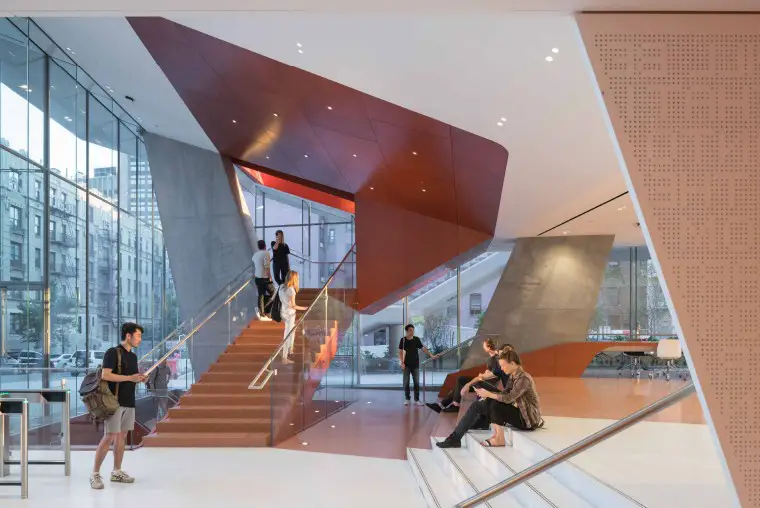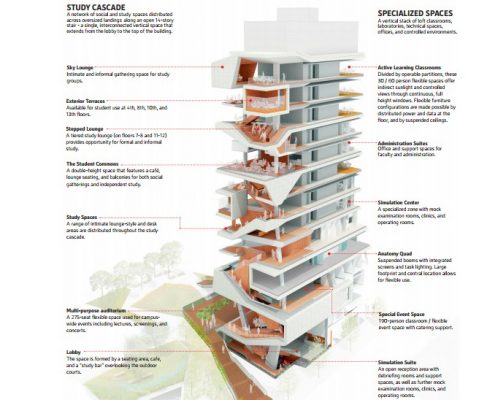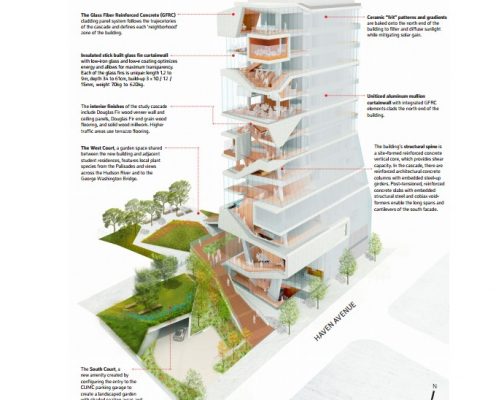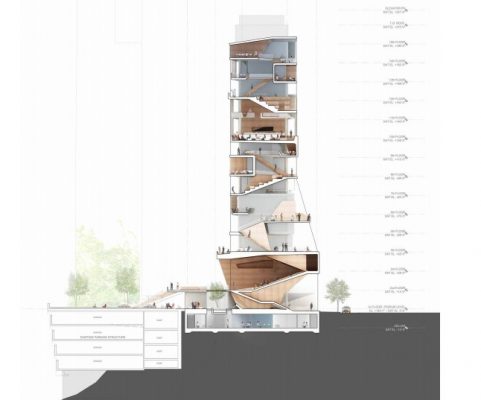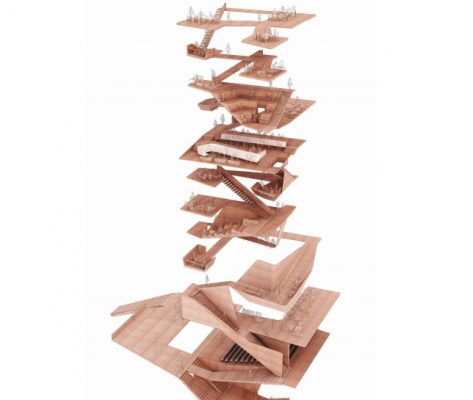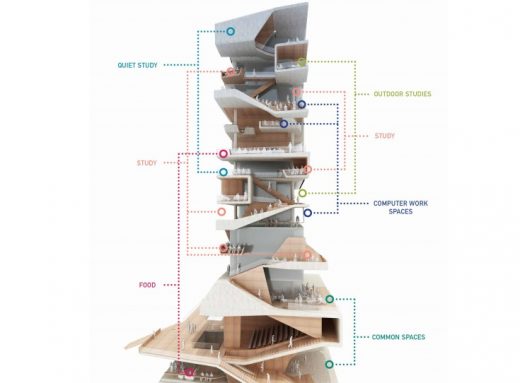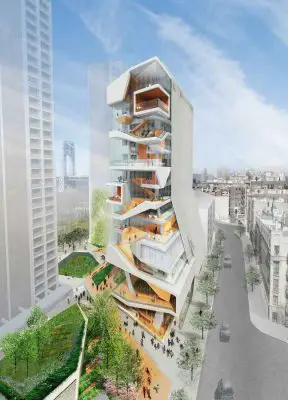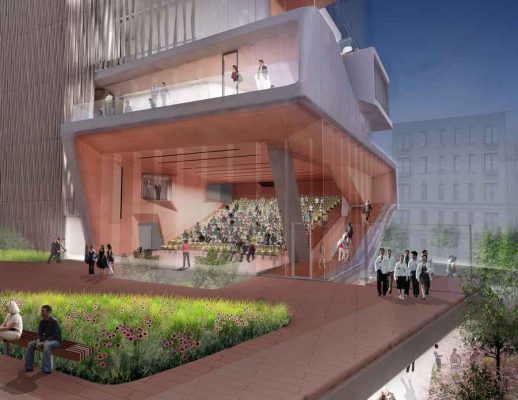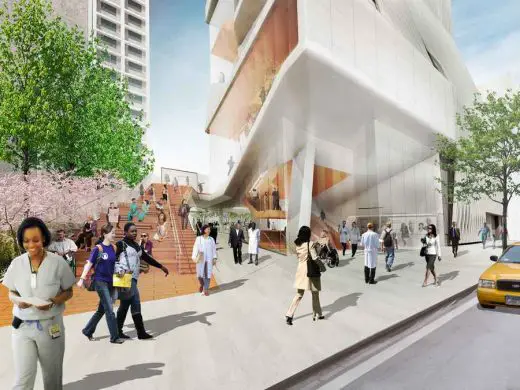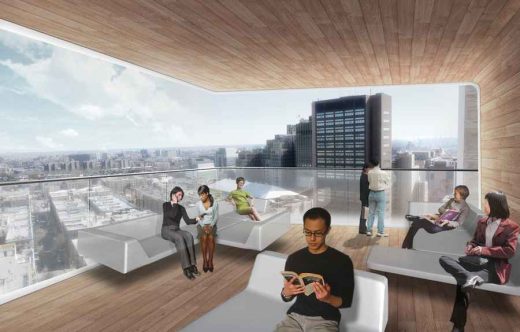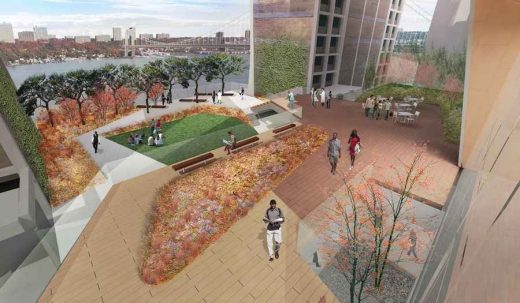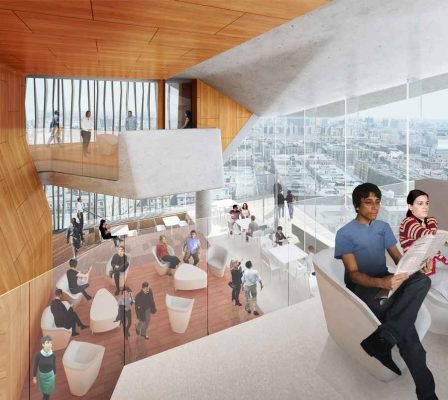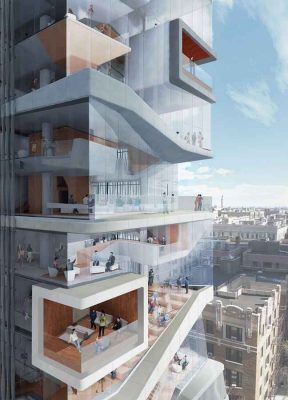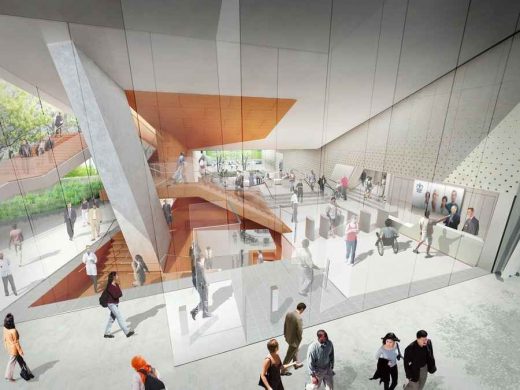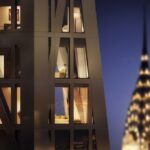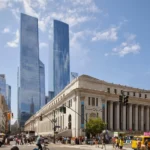Columbia University Medical Center New York, Washington Heights Architecture, CUMC Building
Columbia University Medical Center, New York
CUMC Campus Building, Northern Manhattan – design by Diller Scofidio + Renfro, architects
Mar 25, 2017
The Roy and Diana Vagelos Education Center, Columbia University
2017 AIANY Design Awards Overall Winner
BEST IN COMPETITION
Project: The Roy and Diana Vagelos Education Center, Columbia University
Aerial view:
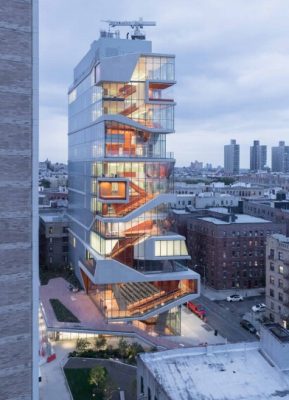
photograph : Iwan Bann
Location: New York, NY
Architect: Diller Scofidio + Renfro
Executive Architect: Gensler
Landscape Architect: SCAPE
Aerial view:
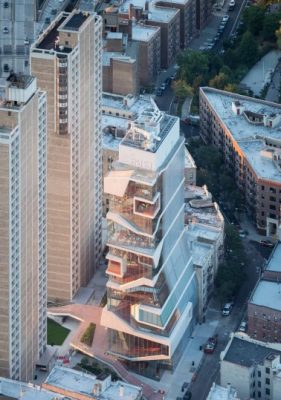
photograph : Iwan Bann
Award for The Roy and Diana Vagelos Education Center New York City
Lobby. The street level entrance to the tower opens to a double-height, tiered lobby, shown here with floor-to-ceiling views of the building’s dense urban context. The main stairway ascends to the Study Cascade, while shallow steps opposite the card-access entrance rise up to an area that offers a variety of seating options, including a study bar, upholstered lounging pieces, and a café:
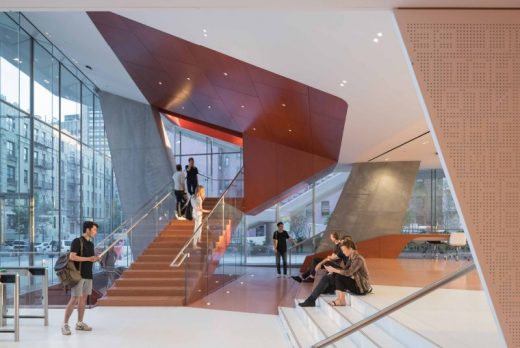
photo : Iwan Bann
View into the social and study spaces that comprise the study cascade:
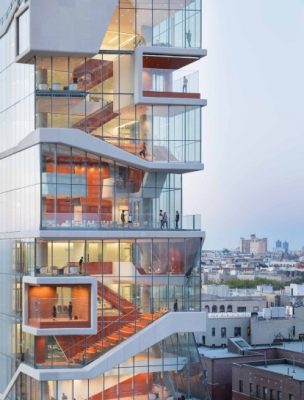
photo : Iwan Bann
Vertically intersecting lobby stairways ascend to join the Study Cascade, and descend to a lower-floor Simulation Suite, comprised of mock clinics, examination rooms, and operating rooms:
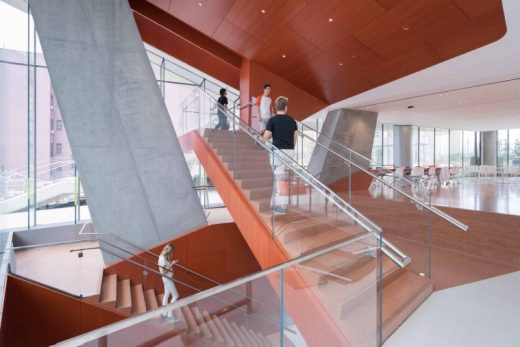
photo : Iwan Bann
View of the 265-seat auditorium and exterior terrace:
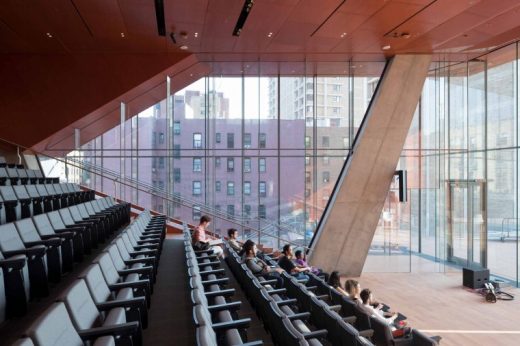
photo : Iwan Bann
Study Cascade Alcove. An unprogrammed space along the Study Cascade, flooded with natural light, provides tiered, fixed upholstered seating that encourages study breaks where students can study with “collective individuality.”
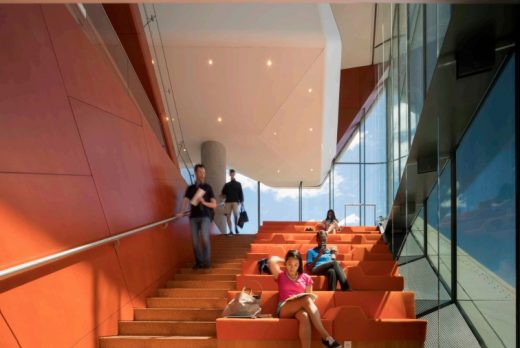
photo : Nic LeHoux
Study Cascade Alcove, Aerial View. An unprogrammed space along the Study Cascade, flooded with natural light, provides tiered, fixed upholstered seating that encourages study breaks where students can study with “collective individuality.”
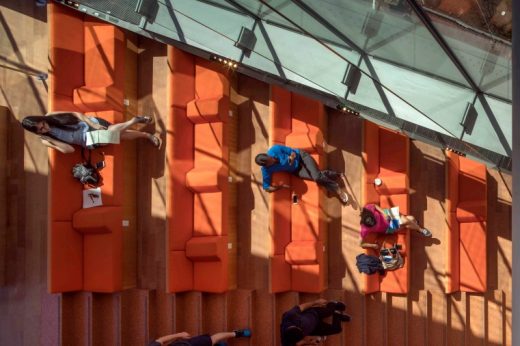
photo : Nic LeHoux
Study Cascade Alcove. An unprogrammed space along the Study Cascade, flooded with natural light, provides tiered, fixed upholstered seating that encourages study breaks where students can study with “collective individuality.”
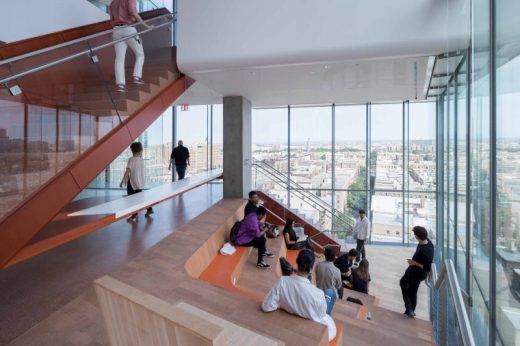
photo : Iwan Bann
The warm, wood-lined interiors of the Study Cascade extend out to adjacent open-air terraces, which provide expansive views of Manhattan to the south.
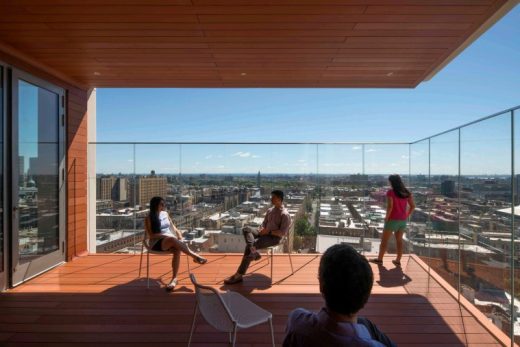
photo : Nic LeHoux
Sky Lounge. The Study Cascade terminates on the 14th floor Sky Lounge, where a range of spatial typologies – intimate and informal, enclosed and formal, lounge and casual – accommodate a variety of study group types.
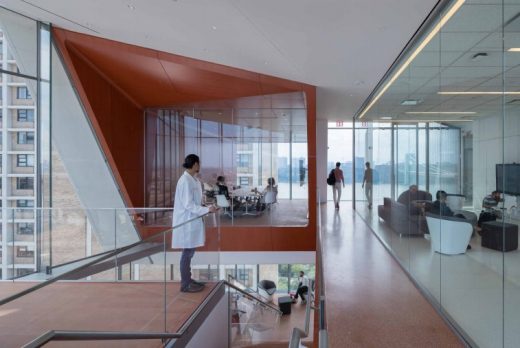
photo : Iwan Bann
Images below courtesy Diller Scofidio + Renfro
Jul 17, 2012
Columbia University Medical Center New York
Columbia University Medical Center Unveils Design for New Medical and Graduate Education Building
Design: Diller Scofidio + Renfro with Gensler
Building design led by Diller Scofidio + Renfro
New York, NY – Columbia University Medical Center (CUMC) recently announced plans for a new, state-of-the-art medical and graduate education building on the CUMC campus in the Washington Heights community of Northern Manhattan.
The new building, with a design led by Diller Scofidio + Renfro, in collaboration with Gensler as executive architect, is a 14-story facility that incorporates technologically advanced classrooms, collaboration spaces, and a modern simulation center, all reflecting how medicine is and will be taught, learned, and practiced in the 21st century.
Images below from Diller Scofidio + Renfro
Construction of this new building is supported by a lead gift of $50 million from P. Roy Vagelos, M.D., a distinguished alumnus of Columbia’s College of Physicians and Surgeons (P&S), and his wife, Diana Vagelos. This gift was announced in September 2010.
The building will become an important landmark to the skyline of Northern Manhattan – as it will be visible from the nearby George Washington Bridge and Riverside Park. Construction is expected to begin in early 2013 and will take approximately 42 months.
“The new building provides upgraded education facilities that reflect the eminence of one of the top medical schools in the world. Both the building and the newly created green space that will surround it will also revitalize our campus in ways that will benefit both our medical center and the entire community,” said Lee Goldman, M.D., dean of the faculties of health sciences and medicine at CUMC and executive vice president for health and biomedical sciences at Columbia University.
Located on existing Columbia property on Haven Avenue between West 171st and West 172nd Streets, the Medical and Graduate Education Building will be used by students from all four CUMC schools (P&S, Nursing, Dental Medicine and the Mailman School of Public Health), and the biomedical departments of the Graduate School of Arts and Sciences. Its high-tech medical simulation center, which will allow hands-on learning in realistic settings, will transform the way CUMC trains health professionals in medicine, dentistry, and nursing, as well as how practicing physicians maintain their clinical skills and learn new techniques.
“The new building will have the best possible design that is attractive, comfortable, and appropriate for the intense kind of education that our students receive,” said Dr. Vagelos, a 1954 graduate of P&S, and former chairman and CEO of Merck & Co. Inc. He is chairman of the CUMC’s Board of Visitors and Defining the Future Campaign “The formal learning space will have state-of-the-art electronics that facilitate the delivery of information to students.
In addition, there will be space where the students can informally interact and work as teams – reflecting our new curriculum which emphasizes team-based learning. And there will also be space to relax and have coffee. It will incorporate every aspect of medical and graduate education – updated in a modern, environmentally responsible way.”
The design weaves together areas for study and other activities. It features technology-enabled classrooms; a state-of-the-art medical simulation center that will replicate clinics, operating rooms and other real world medical environments; innovative learning facilities for both collaboration and quiet study; an auditorium and event areas with integrated technology; centralized student support services; student lounges and cafés; and multiple purpose outdoor spaces, including a terrace with views of the Hudson River.
The “Study Cascade” is the principle design strategy of the building – a network of social and study spaces distributed across oversized landings along an intricate 14-story stair. The Study Cascade creates a single interconnected space the height of the building, stretching from the ground floor lobby to the top of the building, and conducive to collaborative, team-based learning and teaching.
The “Study Cascade” interiors are complemented by a distributed network of south-facing outdoor “rooms” and terraces that are clad with cement panels and wood. While the “Study Cascade” provides an organizational strategy for the building’s interior, it is also an urban gesture that, with its glass façade, aims to become a visual landmark at the northern limit of Columbia University’s medical campus. The northern face of the building houses space for classrooms, clinical simulation and administration and support.
“The new Medical and Graduate Education Building will be the social and academic anchor of the CUMC campus,” said Elizabeth Diller, principal-in-charge of the project Diller Scofidio + Renfro. “Spaces for education and socializing are intertwined to encourage new forms of collaborative learning among students and faculty.”
“The architecture of the (campus) revitalization program is really powerful and brings medical students, dental students, graduate students all together and makes us feel more like we are part of the community,” said Kally Pan, a doctoral candidate in P&S and a member of a student committee that participated in the design process.
The Medical and Graduate Education Building incorporates green design and building techniques that will create a welcoming environment and contribute to the long-term sustainability of the entire neighborhood. The University is planning the building to meet LEED-Gold standards for sustainability.
LEED stands for Leadership in Energy and Environmental Design and is a national design standard for green buildings and sustainability which is administered by the United States Green Building Council (USGBC).
For more than two centuries, Columbia University has been a premier destination for medical education, training generations of outstanding physicians and scientists. It was the first medical school in the United States to award the M.D. degree in 1770. The new building is intended to keep Columbia at the forefront of innovations in medical and graduate science education.
Columbia University Medical Center provides international leadership in basic, pre-clinical and clinical research, in medical and health sciences education, and in patient care. The medical center trains future leaders and includes the dedicated work of many physicians, scientists, public health professionals, dentists, and nurses at the College of Physicians and Surgeons, the Mailman School of Public Health, the College of Dental Medicine, the School of Nursing, the biomedical departments of the Graduate School of Arts and Sciences, and allied research centers and institutions.
Established in 1767, Columbia’s College of Physicians and Surgeons was the first institution in the country to grant the M.D. degree and is among the most selective medical schools in the country. Columbia University Medical Center is home to the largest medical research enterprise in New York City and State and one of the largest in the United States. www.cumc.columbia.edu.
Diller Scofidio + Renfro is an interdisciplinary design studio that integrates architecture, the visual arts, and the performing arts. Based in New York City, the 100-person studio is led by three partners – Elizabeth Diller, Ricardo Scofidio, and Charles Renfro – who work collaboratively on the design of each project in the studio. In 1999, the MacArthur Foundation presented Ms. Diller and Mr. Scofidio with the ‘Genius’ Fellowship for their commitment to integrating architecture with issues of contemporary culture.
Selected projects include: Lincoln Center for the Performing Arts, comprised of the redesign of Alice Tully Hall and the expansion of the Juilliard School, New York City; the High Line Park, New York City; the Institute of Contemporary Art, Boston; Brown University’s Creative Arts Center, Providence; Blur Building, Switzerland; The Broad Museum, Los Angeles; the Museum of Image & Sound, Rio de Janeiro; the Hirshhorn Museum Seasonal Inflatable Pavilion, Washington D.C; and Columbia Business School on the Manhattanville campus, New York City.
Columbia University Medical Center images / information from Diller Scofidio + Renfro
Diller Scofidio + Renfro / Gensler Architects
Location: Columbia University Medical Center, Washington Heights, New York City, USA
New York City Architecture
Contemporary New York Buildings
Manhattan Architecture Designs – chronological list
New York City Architecture Tours by e-architect
Columbia University Buildings – Selection
Columbia University Extension, West Harlem
Design: Renzo Piano Building Workshop (RPBW) with SOM
Columbia University Extension Building
Northwest Corner Building, Columbia University, NYC
José Rafael Moneo
Columbia University Northwest Corner Building
Temple Hoyne Buell Center for the Study of American Architecture
Campbell Sports Center Columbia
George Washington Bridge Bus Station Building Renovation, Northern Manhattan, New York, NY
Design: Dr. Pier Luigi Nervi
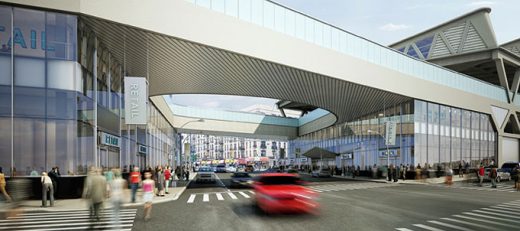
image from architects
Northern Manhattan Building
Comments / photos for the Columbia University Medical Center New York – CUMC Campus Northern Manhattan page welcome
Website: www.cumc.columbia.edu

